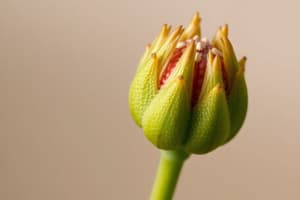Podcast
Questions and Answers
A population of genetically identical bacteria is exposed to a new antibiotic. Which of the following is the most likely outcome, and why?
A population of genetically identical bacteria is exposed to a new antibiotic. Which of the following is the most likely outcome, and why?
- The entire population will likely be wiped out because asexual reproduction produces identical offspring with no variation.
- A small number of bacteria might survive if they happen to have a mutation that provides resistance, demonstrating a limitation of asexual reproduction. (correct)
- The entire population will quickly develop resistance due to the rapid mutation rate in asexual reproduction.
- The bacteria will undergo meiosis to create genetic diversity and adapt to the antibiotic.
A farmer discovers that a fungal disease is rapidly spreading through their crop of asexually reproducing plants. What would be the most effective strategy to prevent complete devastation of their crop in the future?
A farmer discovers that a fungal disease is rapidly spreading through their crop of asexually reproducing plants. What would be the most effective strategy to prevent complete devastation of their crop in the future?
- Continue planting the same crop, as the fungus will eventually run out of resources.
- Cultivate a new crop variety that reproduces sexually to increase genetic diversity. (correct)
- Introduce a new pesticide to kill the fungus and prevent it from spreading further.
- Increase the use of fertilizers to boost the plants' immune systems.
Consider a unicellular organism that thrives in a stable environment. Under what circumstances might this organism evolve to reproduce sexually?
Consider a unicellular organism that thrives in a stable environment. Under what circumstances might this organism evolve to reproduce sexually?
- Never, because unicellular organisms are inherently incapable of sexual reproduction.
- When the organism needs to increase its population size rapidly.
- When the organism exhausts its food supply.
- When the environment becomes unstable and genetic diversity becomes advantageous. (correct)
In a rapidly changing ecosystem, which of the following organisms would be most likely to adapt and survive long-term?
In a rapidly changing ecosystem, which of the following organisms would be most likely to adapt and survive long-term?
Which of the following scenarios would MOST likely result from a population bottleneck in a species that primarily reproduces sexually?
Which of the following scenarios would MOST likely result from a population bottleneck in a species that primarily reproduces sexually?
Flashcards
Asexual Reproduction
Asexual Reproduction
Reproduction where a single organism contributes all genetic material to its offspring, resulting in clones.
Sexual Reproduction
Sexual Reproduction
Reproduction involving two individuals contributing genetic material, creating offspring with a mix of traits.
Mitosis
Mitosis
Process where a cell replicates its genetic material and divides into two identical daughter cells.
Meiosis
Meiosis
Signup and view all the flashcards
Unicellular Reproduction
Unicellular Reproduction
Signup and view all the flashcards
Study Notes
- Reproduction is the process by which an organism creates more of its own kind. It occurs through either asexual or sexual means.
Asexual Reproduction
- Asexual reproduction involves a single organism contributing 100% of the genetic code to its offspring, resulting in clones of the parent.
- Commonly seen in unicellular organisms because it requires less energy.
- During mitosis, a cell replicates its genetic material and divides into two identical daughter cells through cytokinesis.
- Bacteria, yeast, and archaebacteria commonly reproduce asexually. Some plants and animals also use this method under certain conditions.
- Some bacteria share DNA through plasmids, allowing for limited genetic exchange, not as extensive as sexual reproduction.
- Benefits include rapid population rebuilding from a single organism and lower resource and time requirements.
- Sponges can reproduce by budding, where a part of the organism pinches off and grows into a new individual. Some plants, like citrus trees, can produce fruit with seeds without fertilization.
- A key disadvantage is the lack of genetic diversity, making the entire population vulnerable to diseases or environmental changes. The Irish potato famine serves as an example where a blight wiped out genetically similar potatoes.
- Types of asexual reproduction include budding (sea sponges), binary fission (bacteria), sporogenesis (molds, bacteria, fungi), fragmentation, and vegetative propagation (strawberries using runners).
Sexual Reproduction
- Sexual reproduction involves two individuals contributing genetic information to create offspring, resulting in a hybrid with traits from both parents.
- Commonly used by multicellular organisms with complex organ systems.
- It allows for genetic diversity, enabling the species to adapt to changing environments and resist diseases. Mutations can be discarded before they reach the offspring.
- Sexual reproduction involves sex or gender, with male and female individuals or hermaphrodites (organisms with both genders).
- It involves the fusion of two sex cells from different individuals to form a zygote, which develops into a new individual.
- Fertilization, the fusion of genetic information, can occur internally (mammals) or externally (frogs, fish, flowering plants).
Asexual Cells and Sex Cells
- Asexual reproduction usually occurs in simpler organisms, where any somatic cell can reproduce.
- Mitosis involves the splitting of a somatic cell into two identical cells, forming new organisms or spores.
- Meiosis involves the splitting of a cell with all genetic information into two cells with half the genetic information (haploid cells or gametes).
- Somatic cells double their genetic material before mitosis, while sex cells undergo two divisions during meiosis to produce haploid gametes.
- Gametes (sex cells) are typically eggs (female) and sperm (male).
- Plants use pollen, carried by wind or pollinators, to transfer male gametes. Mammals have motile sperm for internal fertilization, while aquatic animals may have external fertilization.
Gametogenesis
- Gametogenesis is the process of making sex cells, including oogenesis (making eggs) and spermatogenesis (making sperm).
- Both processes start with a diploid parent cell undergoing mitosis and meiosis to produce up to four haploid daughter cells
- In females, eggs are made while the fetus is still developing
- In males, spermatogenesis takes place in the reproductive system throughout their reproductive lifespan.
Oogenesis
- Begins in the pre-natal stage, where primary oocytes stop in meiosis I
- The antral stage sees primary oocytes surrounded by a follicle and antrum, with one daughter cell retaining most cytoplasm
- Puberty triggers the antral stage through luteinizing hormone (LH) and follicle stimulating hormone (FSH).
- Before ovulation, LH releases the follicle from the ovary where it goes through the fallopian tube and proceeds to metaphase of meiosis II, eventually halting again.
- The process will only finish if fertilization happens and a true ovum is formed
Spermatogenesis
- This is divided into three stages: spermatocytogenesis, spermatidogenesis, and spermiogenesis.
- Spermatocytogenesis is were diploid stem cells divide into haploid spermatocytes
- In spermatidogenesis, the secondary spermatocytes undergo meiosis II to form haploid spermatids quickly.
- Finally spermiogenesis occurs when the spermatids change physiologically to become fully functional sperm cells.
Mitosis and Meiosis
- Mitosis is a cellular division process resulting in diploid cells, not always leading to more organisms.
- Meiosis is specifically for reproduction, halving genetic material to be restored later.
- Meiosis will never be used for asexual reproduction
- In rare cases, an ovum can grow without fertilization, completing the individual.
Asexual vs Sexual Reproduction
- Asexual reproduction involves a parent cell splitting via mitosis to produce 2 identical diploid daughter cells.
- Sexual reproduction has undifferentiated ells going through meiosis to produce 4 haploid gametes.
- Mitosis includes prophase, metaphase, anaphase, telophase and cytokinesis
- Meiosis has two sets of prophase, metaphase, anaphase, telophase and cytokinesis
- Mitosis can occur in any somatic cell that replicates quickly
- Meiosis is only used for the purposes of gamete production
- Mitosis is common is single celled reproduction
- Meiosis takes place in complex organisms with complex gametes
Plant vs Animal Reproduction
- Humans reproduce sexually, the end result is is a child with similar genetics from both the mother and the father
- Plants can reproduce both sexually and asexually, strawberries send out clones while onions tubers, potatoes and ginger reproduce asexually.
- Plants that sexually reproduce make seeds and pollen and can utilize insects and animals to spread the seeds and pollen to other plants
- Flowers contain the sexual organs of the plant and pollinators can transfer pollen from plant to plant through the air, fertilzing the ova and thus spreading seeds for reproduction.
Studying That Suits You
Use AI to generate personalized quizzes and flashcards to suit your learning preferences.




